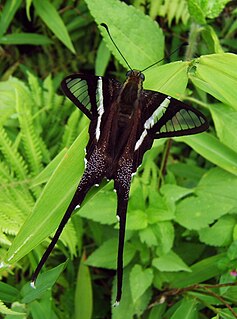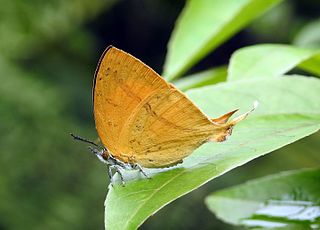Related Research Articles

Lamproptera curius, the white dragontail, is a species of swallowtail butterfly native to parts of South Asia and Southeast Asia where it is common. It belongs to the dragontails genus, Lamproptera, of the swallowtail family, Papilionidae.

Loxura atymnus, the yamfly, is a species of lycaenid or blue butterfly found in Asia.

Grammodes stolida, the geometrician, is a moth of the family Erebidae. The species was first described by Johan Christian Fabricius in 1775. It is found in Africa, southern Europe, most of Asia and Australia. It migrates to central and northern Europe as far north as England, Denmark and Finland.

Acraea uvui, the tiny acraea or tiny mountain acraea, is a butterfly of the family Nymphalidae. It is found in Cameroon, Angola, northern Tanzania, Kenya, Rwanda, Uganda, Burundi and eastern Zaire. The habitat consists of sub-montane forests at altitudes ranging from 1,200 to 1,400 meters.
Cosmopterix madeleinae is a moth of the family Cosmopterigidae. It is known from the Galapagos Islands.
Cosmopterix pentachorda is a moth of the family Cosmopterigidae. It is known from Ecuador and Peru.
Pebobs elara is a moth of the family Cosmopterigidae. It is known from Cuba and Jamaica.

Pulveroboletus auriflammeus, commonly known as the flaming gold bolete, is a species of bolete fungus in the family Boletaceae. Described as new to science in 1872, it is found in eastern North America, where it grows in a mycorrhizal association with oaks. The caps of the fruit bodies are golden orange, with a yellow pore surface on the underside, and a reticulated (network-like) stem. The edibility of the mushroom is not known.
Colias aquilonaris is a butterfly in the family Pieridae found only on the Chukchi Peninsula in the Russian Far East and along the valleys of the rivers Olenyok and Yana.
Imma cosmoplaca is a moth of the family Immidae. It is found on Java.
Charistica callichroma is a moth in the family Gelechiidae. It was described by Edward Meyrick in 1914. It is found in Guyana and possibly Amazonas, Brazil.
Cryptophasa tetrazona is a moth in the family Xyloryctidae. It was described by Oswald Bertram Lower in 1901. It is found in Australia, where it has been recorded from New South Wales, Queensland, Victoria and Western Australia.
Comotechna ludicra is a moth in the family Depressariidae. It was described by Edward Meyrick in 1920. It is found in Guyana.
Enchocrates phaedryntis is a moth in the family Depressariidae. It was described by Edward Meyrick in 1888. It is found in Australia, where it has been recorded from Western Australia.
Gonionota militaris is a moth in the family Depressariidae. It was described by Edward Meyrick in 1914. It is found in Colombia.
Eupselia tristephana is a moth in the family Depressariidae. It was described by Edward Meyrick in 1915. It is found in Australia, where it has been recorded from Western Australia, the Northern Territory and Queensland.
Hypercallia phlebodes is a moth in the family Depressariidae. It was described by Lord Walsingham in 1912. It is found in Guatemala.
Timocratica fraternella is a moth in the family Depressariidae. It was described by August Busck in 1910. It is found in Costa Rica.
Timocratica major is a moth in the family Depressariidae. It was described by August Busck in 1911. It is found in Peru and Brazil.
Timocratica monotonia is a moth in the family Depressariidae. It was described by Embrik Strand in 1911. It is found in Brazil (Amazonas), Guyana, Venezuela, Colombia, Ecuador and Peru.
References
- ↑ Timocratica at Markku Savela's Lepidoptera and Some Other Life Forms.
- ↑ Proceedings of the Entomological Society of Washington 11 (4): 212
| This article on a moth of the family Depressariidae is a stub. You can help Wikipedia by expanding it. |